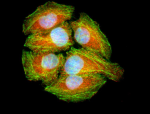- Clone
- K41007 (See other available formats)
- Regulatory Status
- RUO
- Other Names
- Heat Shock Protein 90 kD Alpha (Cytosolic), Class A Member 1, HSPC1, HSP86, HSP89A, HSPCAL4, LAP2, EL52 and HSP90N
- Isotype
- Mouse IgG1
- Ave. Rating
- Submit a Review
- Product Citations
- publications

-
HeLa cells were fixed with 2% paraformaldehyde (PFA) for 10 minutes, permeabilized with 0.5% Triton X-100 for 5 minutes, and blocked with 5% FBS for 30 minutes. Cells were stained with 2 µg/ml anti-HSP90α (clone K41007) in blocking buffer overnight at 4°C, followed by DyLight™ 594 (red) conjugated anti-mouse IgG for two hours at room temperature. Cells were then stained with Alexa Fluor® 488 Phalloidin (green) for 20 minutes at 4°C. Nuclei were counterstained with DAPI (blue). The image was captured with a 40X objective. -

HeLa cells were fixed with 2% paraformaldehyde (PFA) for 10 minutes, permeabilized with 0.5% Triton X-100 for 5 minutes, and blocked with 5% FBS for 30 minutes. Cells were stained with 2 µg/ml anti-HSP90α (clone K41007) in blocking buffer overnight at 4°C, followed by DyLight™ 594 (red) conjugated anti-mouse IgG for two hours at room temperature. Cells were then stained with Alexa Fluor® 488 Phalloidin (green) for 20 minutes at 4°C. Nuclei were counterstained with DAPI (blue). The image was c
| Cat # | Size | Price | Quantity Check Availability | Save | ||
|---|---|---|---|---|---|---|
| 661702 | 100 µg | 212€ | ||||
Hsp90 is one of the most abundant molecular chaperones. It modulates the stability and transport of a diverse set of critical factors, including regulatory, metabolic, organizational, and signaling proteins. There are two major isoforms: α and β. In humans, the Hsp90β isoform is constitutively expressed, whereas the Hsp90α isoform is expressed under stress conditions. The Hsp90 dimer acts in concert with other chaperones and is regulated by a number of co-chaperones/accessory proteins. Upregulation of Hsp90 is associated with tumor progression, invasion and formation of metastases, and development of drug resistance. Therefore Hsp90 has emerged as an important target for cancer treatment.
Product DetailsProduct Details
- Verified Reactivity
- Human, Mouse
- Antibody Type
- Monoclonal
- Host Species
- Mouse
- Immunogen
- Amino acids 702-716 of human HSP90α
- Formulation
- Phosphate-buffered solution, pH 7.2, containing 0.09% sodium azide.
- Preparation
- The antibody was purified by affinity chromatography.
- Concentration
- 0.5 mg/ml
- Storage & Handling
- The antibody solution should be stored undiluted between 2°C and 8°C.
- Application
-
WB - Quality tested
ICC - Verified
ELISA - Reported in the literature, not verified in house - Recommended Usage
-
Each lot of this antibody is quality control tested by Western blotting. For Western blotting, the suggested use of this reagent is 2.0 - 4.0 µg per ml. It is recommended that the reagent be titrated for optimal performance for each application.
- Application Notes
-
1. Matsusaka T. 1996. Jpn. J. Oral. Biol. 38:633.
2. Nemoto T, et al. 1997. J. Biol. Chem. 272:26179. (ELISA)
3. Nemoto T, et al. 1997. Biochemistry and Mol. Biol. International. 42:881. - RRID
-
AB_2564178 (BioLegend Cat. No. 661702)
Antigen Details
- Structure
- 732 amino acids, predicted molecular weight of approximately 85 kD.
- Distribution
-
Mostly cytoplasmic, some nuclear.
- Function
- Hsp90 is one of the most abundant molecular chaperones. It modulates the stability and transport of a diverse set of critical factors, including regulatory, metabolic, organizational, and signaling proteins.
- Interaction
- NR3C1, FKBP4, FKBP5, PPID, PPP5C, STIP1, AHSA1, FNIP1, HSF1, SMYD3, TOM34, TERT, PTGES3, CHORDC1, DNAJC7, STUB1, UBE2N, PPP5C and PPP5C.
- Cross
- Very weakly cross-react with mouse.
- Biology Area
- Cell Biology, Cell Cycle/DNA Replication, DNA Repair/Replication, Neurodegeneration, Neuroinflammation, Neuroscience, Protein Trafficking and Clearance, Signal Transduction
- Antigen References
-
1. Barrott JJ, et al. 2013. FEBS J. 280:1381.
2. Gorska M, et al. 2012. Front. Biosci. (Landmark Ed) 17:2269.
3. Barginear MF, et al. 2008. Curr. Cancer Drug Targets. 8:522.
4. Arya R, et al. 2007. J. Biosci. 32:595.
5. Neckers L, et al. 2003. Curr. Opin. Oncol. 15:419.
6. Nemoto T, et al. 1997. J. Biol. Chem. 272: 26179. - Gene ID
- 3320 View all products for this Gene ID
- UniProt
- View information about Hsp90alpha on UniProt.org
Related FAQs
Other Formats
View All Hsp90α Reagents Request Custom Conjugation| Description | Clone | Applications |
|---|---|---|
| Purified anti-Hsp90α | K41007 | WB,ICC,ELISA |
Compare Data Across All Formats
This data display is provided for general comparisons between formats.
Your actual data may vary due to variations in samples, target cells, instruments and their settings, staining conditions, and other factors.
If you need assistance with selecting the best format contact our expert technical support team.
 Login / Register
Login / Register 










Follow Us